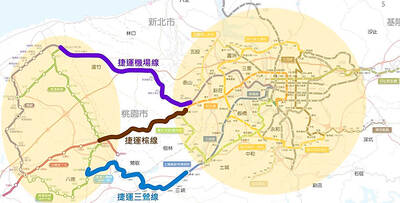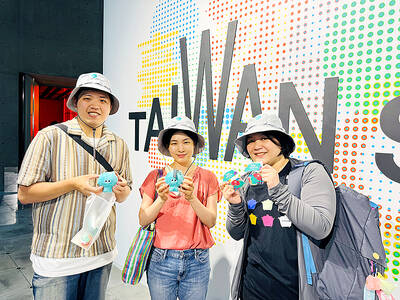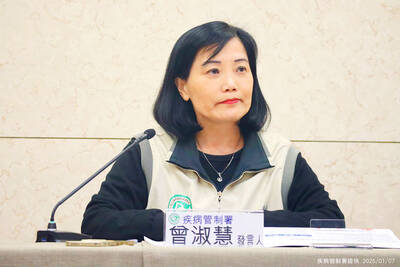Miss Hsu (徐) works in a technology firm. She exercises regularly and measures her blood pressure often. She watches what she eats and records her daily food intake. She usually writes all of this information on a piece of paper, which could be lost easily.
Now she enters all of this information in a "Health Notebook" (健康筆記), issued by the Taiwan Health Reform Foundation, allowing her to conveniently keep tabs on all her personal health information -- everything from weight, blood pressure and waistline measurements to the number of hours she works out. Hsu can also attach prescriptions and reminders from doctors and even receipts for clinical services in the notebook.
The creation of the notebook was inspired by the personal story of the foundation's chairwoman Chang Li-yun (張苙雲), who was recently diagnosed with hyperthyroidism.
Chang kept a journal in which she wrote items such as the names of the medication she took, the dosage and the results of blood tests. She also jotted down some of the symptoms she observed, such as heart palpitations, weariness and perspiration.
The foundation's executive director, Liu Mei-chun (劉梅君), said the Department of Health has been promoting the concept of health self-management for years, but she said few actually know what that means, much less practice it.
The concept suggests that one is fully responsible for doing whatever it takes to stay fit and manage his or her own illness.
Liu said that most people go to the doctor without a full grasp of their health condition. Even after they have returned home from the clinic, they may still remain unclear about the doctor's instructions.
"Under these circumstances, an information gap occurs between doctors and patients ," she said.
Liu said the notebook not only enables individuals to describe their symptoms in detail, but also helps doctors make a more accurate diagnosis of the diseases that the patients may have.
Besides the sections of the notebook reserved for entries on personal health information, the notebook also includes useful medical information at the back.
For example, the foundation suggests patients seek the answers to six critical questions whenever they see a doctor, such as the name of the medications they take and when they should return for a follow-up appointment.
Ho Yi-hsuan (何怡萱), a mother, said at a press conference yesterday that she used the notebook to record the growth of her eight-month-old son and to chart such things as the day he learned how to crawl.
Coming with three different cover designs, the Health Notebook costs NT$160 per copy including the cost of delivery and can only be purchased online at the foundation's Web site (www.thrf.org.tw).
The foundation hopes the sale of the notebooks will help raise funds for its operations, which is facing a NT$2 million (US$60,000) deficit this year.

The Executive Yuan yesterday approved a southwestern extension of the Sanying MRT Line from New Taipei to Bade District (八德) in Taoyuan, with a goal of starting construction by late 2026. The 4.03-kilometer extension, featuring three new stations, will run from the current terminus at Yingtao Fude Station (LB12) in New Taipei City to Dannan Station (LB14), where it will connect with Taoyuan’s Green Line, New Taipei City Metro Corp said in a statement. This extension will follow the completion of core Sanying Line, a 14.29-kilometer medium-capacity system linking Tucheng (土城), Sansia (三峽)

CARGO LOSS: About 50 containers at the stern of the ‘Ever Lunar’ cargo ship went overboard, prompting the temporary closure of the port and disrupting operations Evergreen Marine Corp, Taiwan’s largest container shipper, yesterday said that all crew members aboard the Ever Lunar (長月) were safe after dozens of containers fell overboard off the coast of Peru the previous day. The incident occurred at 9:40am on Friday as the Ever Lunar was anchored and waiting to enter the Port of Callao when it suddenly experienced severe rolling, Evergreen said in a statement. The rolling, which caused the containers to fall, might have been caused by factors including a tsunami triggered by an earthquake in Russia, poor winter sea conditions in South America or a sudden influx of waves,

The Ministry of Culture yesterday officially launched the “We TAIWAN” cultural program on Osaka’s Nakanoshima sandbank, with the program’s mascot receiving overwhelming popularity. The cultural program, which runs from Aug. 2 to 20, was designed to partner with and capitalize on the 2025 World Expo that is being held in Osaka, Japan, from April 13 to Oct. 13, the ministry said. On the first day of the cultural program, its mascot, a green creature named “a-We,” proved to be extremely popular, as its merch was immediately in high demand. Long lines formed yesterday for the opening

BE CAREFUL: The virus rarely causes severe illness or death, but newborns, older people and those with medical conditions are at risk of more severe illness As more than 7,000 cases of chikungunya fever have been reported in China’s Guangdong Province this year, including 2,892 new cases last week, the Centers for Disease Control (CDC) yesterday said it is monitoring the situation and considering raising the travel notice level, which might be announced today. The CDC issued a level 1 travel notice, or “watch,” for Guangdong Province on July 22, citing an outbreak in Foshan, a manufacturing hub in the south of the province, that was reported early last month. Between July 27 and Saturday, the province reported 2,892 new cases of chikungunya, reaching a total of 7,716